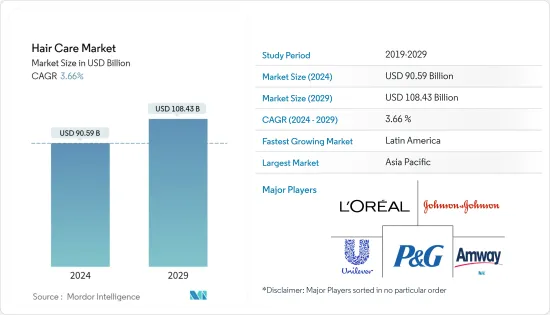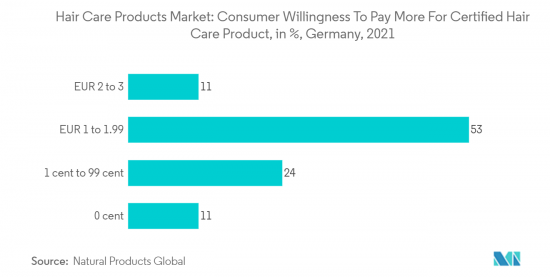PUBLISHER: Mordor Intelligence | PRODUCT CODE: 1403095

PUBLISHER: Mordor Intelligence | PRODUCT CODE: 1403095
Hair Care - Market Share Analysis, Industry Trends & Statistics, Growth Forecasts 2024 - 2029

The Hair Care Market size is estimated at USD 90.59 billion in 2024, and is expected to reach USD 108.43 billion by 2029, growing at a CAGR of 3.66% during the forecast period (2024-2029).
Post the COVID-19 pandemic, consumers in the global marketplace have adopted notable trends, such as do-it-yourself (DIY) beauty care. As a result, DIY hair coloring is finding new customers. Furthermore, increasing celebrity endorsements and rising awareness about the harmful effects of chemicals and synthetic products augment the demand for natural/organic and vegan hair care products, along with ease of use and availability of small travel-size packs. These are significant trends observed in the global shampoo market.
Furthermore, the growing demand for organic/natural products for personal grooming has become one of the primary concerns for individuals. Among organic hair care products, owing to their wide usage, conditioners and shampoos held a majority share in the global organic haircare market. As a result, manufacturers are expanding their product portfolios by investing heavily in research and development to incorporate organic/natural and clean-label ingredients in the formulation of their hair care products, including shampoos, and cater to the increasing consumer demand. Furthermore, anti-dandruff organic hair oils are expected to register robust growth over the forecast period.
Hair Care Market Trends
Growing Demand for Organic Hair Care Products
The global market is witnessing an increasing demand for natural and organic products due to the rise in consumer awareness about the harmful effects of certain compounds, such as paraben and aluminum compounds, present in hair care products. In recent years, this has increased the demand for natural and organic hair care products. A high percentage of consumers choose one brand over others based on its organic formulation. According to a study conducted by DSM, 56% of consumers place more importance on active ingredients than brand, package, or fragrance in purchasing decisions.
The high demand for natural ingredients has been quite evident in the market studied, which has led to the majority of companies launching products with nature-inspired ingredients, such as plant-inspired and premium botanical ingredients. For instance, in May 2021, AVA Group's flagship brand, Medimix, launched a shampoo with natural ingredients, Total Care Shampoo, as part of its reputable line of beauty products.
Among the organic hair care product types, conditioners and shampoos hold a majority of the share in the global organic hair care market, owing to their wide usage. Furthermore, anti-dandruff organic hair oils are expected to register robust growth during the forecast period. The demand for organic hair care products in Western Europe is expected to increase at a substantial rate. Moreover, the growing personal care industry is expected to boost the market in Latin America.

Asia-Pacific is the Fastest Growing Region
Asia-Pacific is the fastest-growing region across the globe owing to the fact that there is a high presence of the millennial population, increased migration to cities, and the growing number of women in the workforce. Due to the migration of a large population to urban areas, traditional hair care products have experienced high growth in the market.
China is the second-largest market for hair care products worldwide, only after the United States. In the Asia-Pacific region, the country holds the largest market share and is expected to hold its position during the forecast period, further increasing the demand for hair care products in the overall Asia-Pacific region, which, in turn, increases the potential of Asia-Pacific to become one of the largest markets of hair care products in the next five to ten years.
The usage of premium hair care products is most prevalent in the megacities of Asia-Pacific countries. This is likely to increase further with the growing middle class and consumption of consumer products. The increasing internet penetration and push of e-commerce companies to attract consumers is driving sales from e-commerce in the Asia-Pacific region, while sales from physical retail channels continue to dominate the market.
Hair Care Industry Overview
The industry leaders include L'Oreal SA, Henkel AG & Co. KGaA, Unilever, and Procter & Gamble. The key players are actively focusing on gaining larger market shares through constant innovation in products and investments in R&D for the development of niche products. Considering the above-mentioned factors, the competitive rivalry in the industry is assessed to be high. Apart from product innovations and mergers and acquisitions, the market players are considering environmental and human health issues and adopting sustainable initiatives to accelerate the global beauty industry's progress in addressing plastic waste,
Additional Benefits:
- The market estimate (ME) sheet in Excel format
- 3 months of analyst support
TABLE OF CONTENTS
1 INTRODUCTION
- 1.1 Study Deliverables and Study Assumptions
- 1.2 Scope of the Study
2 RESEARCH METHODOLOGY
3 EXECUTIVE SUMMARY
4 MARKET DYNAMICS
- 4.1 Market Drivers
- 4.2 Market Restraints
- 4.3 Porter's Five Forces Analysis
- 4.3.1 Bargaining Power of Suppliers
- 4.3.2 Bargaining Power of Buyers
- 4.3.3 Threats of New Entrants
- 4.3.4 Threat of Substitute Product and Services
- 4.3.5 Competitive Rivarly In the Industry
5 MARKET SEGMENTATION
- 5.1 Type
- 5.1.1 Shampoo
- 5.1.2 Conditioner
- 5.1.3 Hair Loss Treatment Products
- 5.1.4 Hair Colorants
- 5.1.5 Hair Styling Products
- 5.1.6 Perms and Relaxants
- 5.1.7 Other Product Types
- 5.2 Distribution Channel
- 5.2.1 Hypermarket/Supermarket
- 5.2.2 Specialty Store
- 5.2.3 Online Stores
- 5.2.4 Pharmacies/ Drug Stores
- 5.2.5 Convenience Stores
- 5.2.6 Other Distribution Channels
- 5.3 Geography
- 5.3.1 North America
- 5.3.1.1 United States
- 5.3.1.2 Canada
- 5.3.1.3 Mexico
- 5.3.1.4 Rest of North America
- 5.3.2 Europe
- 5.3.2.1 Germany
- 5.3.2.2 Italy
- 5.3.2.3 Spain
- 5.3.2.4 United Kingdom
- 5.3.2.5 France
- 5.3.2.6 Russia
- 5.3.2.7 Rest of Europe
- 5.3.3 Asia-Pacific
- 5.3.3.1 India
- 5.3.3.2 China
- 5.3.3.3 Japan
- 5.3.3.4 Australia
- 5.3.3.5 Rest of Asia-Pacific
- 5.3.4 South America
- 5.3.4.1 Brazil
- 5.3.4.2 Argentina
- 5.3.4.3 Rest of South America
- 5.3.5 Middle East and Africa
- 5.3.5.1 Saudi Arabia
- 5.3.5.2 South Africa
- 5.3.5.3 Rest of Middle East and Africa
- 5.3.1 North America
6 COMPETITIVE LANDSCAPE
- 6.1 Market Share Analysis
- 6.2 Most Adopted Strategies
- 6.3 Company Profiles
- 6.3.1 Shiseido Company Limited
- 6.3.2 Johnson & Johnson Services Inc.
- 6.3.3 Unilever
- 6.3.4 Amway
- 6.3.5 Oriflame Cosmetics AG
- 6.3.6 Procter & Gamble Co.
- 6.3.7 L'Oreal SA
- 6.3.8 Revlon Inc.
- 6.3.9 Kao Corporation
- 6.3.10 Beiersdorf AG
7 MARKET OPPORTUNITIES AND FUTURE TRENDS




